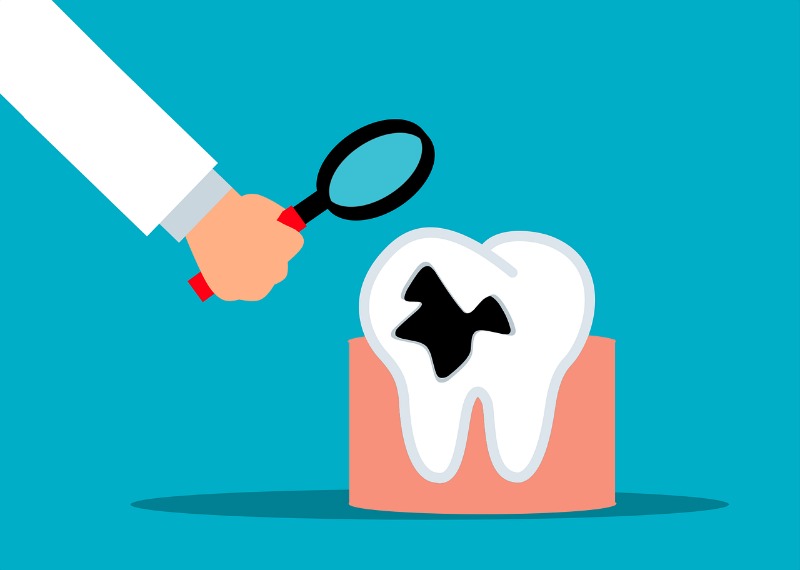
You might have heard your Glendale dentist utter the term “cavity” during regular check-ups. But what are cavities exactly? How do these “dark spots on a tooth” emerge and how can we protect ourselves against them? This informative guide seeks to provide a thorough understanding of dental cavities, their causes, prevention strategies, and early signs to look out for.
Decoding Dental Cavities
A cavity, otherwise known as tooth decay or dental caries, can be visualized as a “tiny hole” in a tooth. If these cavities are “left untreated”, they can grow, potentially leading to tooth loss, a situation you want to avoid at all costs. Let’s break down how these “cavities form” and how we can prevent them.
What Causes Cavities?
The onset of dental cavities is primarily attributed to two common factors: the accumulation of bacteria in the mouth due to poor oral hygiene and the consumption of a diet high in sugars and starch. When we neglect to “brush our teeth” regularly, the bacteria in our mouth increase, forming a plaque on the teeth. Consuming sugary foods and beverages and “eating or drinking” such “foods and drinks” excessively can leave “food particles” on the teeth, promoting tooth decay and eventually causing “gum disease”.
Spotting the Signs of Cavities
Identifying a cavity during the “early stage” can be tricky, especially to the “naked eye”. However, this is why regular dental check-ups with your Glendale dentist are so vital. They can help detect the problem as early as possible, even when the decayed tooth just starts to cause pain or exhibits “tooth sensitivity” to cold foods and drinks. A “persistent bad breath” may also be a “sign of a cavity”.
Preventing Cavities: Tips from Your Glendale Dentist
Prevention is the best approach when it comes to dealing with cavities. Brushing your teeth twice a day with “fluoride toothpaste”, flossing regularly, maintaining a balanced diet, and regular dental visits can go a long way to “prevent cavities”. These practices help to remove the “food particles” and plaque that could lead to cavities and “gum disease”.
Remember, “white spots” on your teeth or “persistent bad breath” could be an early “sign of a cavity” and an indicator of deteriorating “oral health”. If you notice any of these signs, make sure to “visit your dentist” promptly.
Understanding the Warning Signs: Dark Spots on a Tooth and Beyond
 Alongside the general discomfort and sensitivity that a cavity can cause, there are other signs to watch out for. One significant sign of a cavity is the presence of dark spots on a tooth. These dark spots can range from brown to black and are usually a clear indication that tooth decay has begun. They often signal a more advanced stage of decay, where the enamel has been significantly eroded, exposing the inner layers of the tooth.
Alongside the general discomfort and sensitivity that a cavity can cause, there are other signs to watch out for. One significant sign of a cavity is the presence of dark spots on a tooth. These dark spots can range from brown to black and are usually a clear indication that tooth decay has begun. They often signal a more advanced stage of decay, where the enamel has been significantly eroded, exposing the inner layers of the tooth.
Eating or Drinking and Tooth Decay
The role of your diet in cavity formation is crucial. Eating or drinking high-sugar and high-carbohydrate foods and drinks can increase the risk of developing cavities. Bacteria in your mouth consume these sugars and release acids as a byproduct, which can damage the tooth enamel over time. That’s why it’s essential to maintain a balanced diet and limit the consumption of sugary foods and beverages.
The Role of Proper Hygiene: Have You Brushed Your Teeth?
The first line of defense against cavities is proper oral hygiene. This starts with the simple question: have you brushed your teeth? Brushing at least twice a day, especially after meals, helps to remove food particles and plaque from your teeth. Use fluoride toothpaste, as fluoride helps strengthen the enamel and reduce the risk of cavities. Remember to replace your toothbrush every three months or when the bristles start to fray.
Preventing Cavities: Flossing and Fluoride Toothpaste
While brushing helps clean the flat surfaces of your teeth, dental floss removes food particles and plaque from between your teeth and under the gumline where your toothbrush can’t reach. Flossing at least once a day is an essential part of maintaining good oral health. Furthermore, using a fluoride toothpaste can further protect your teeth. Fluoride helps to harden the enamel, making your teeth more resistant to the acid produced by plaque bacteria.
Recognizing Gum Disease and Its Connection to Cavities
Gum disease, or periodontal disease, is a condition that can increase your risk of developing cavities. Inflamed gums can pull away from the teeth, creating pockets where bacteria can accumulate and cause decay. Regular dental check-ups can help detect gum disease in its early stages before it leads to more severe problems.
Is a Tiny Hole a Sign of a Cavity?
Yes, a tiny hole can indeed be a sign of a cavity. Cavities form when tooth decay erodes the enamel, creating a hole. Initially, this hole may be so small that it’s not visible to the naked eye, but as the decay progresses, the cavity becomes larger and more noticeable.
Don’t Delay Dental Care: Spotting the Signs Early
Regular visits to your dentist in Glendale can help catch cavities early, while they’re still small and easier to treat. If you’re noticing signs like dark spots on a tooth, a tiny hole, or sensitivity when eating or drinking, don’t delay your dental appointment. Our team at Smile Makeover of LA is ready to provide you with the dental care you need to keep your smile healthy and bright.
At our Glendale dental clinic, Dr. Sahakyan provides comprehensive advice on maintaining good oral health and preventing cavities. He can guide you on the best practices to keep your teeth healthy and free from cavities.
Schedule an Appointmentat Smile Makeover of LA Glendale Location today. Your journey towards excellent oral health begins with understanding how to prevent cavities and maintain a bright, healthy smile.
